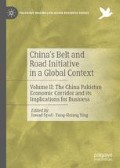Abstract
The world population is growing, putting added pressure on scarce life-supporting resources of the Earth. Individuals and societies look for a better quality of services which implies compatible economic growth. Sustainable economic growth for the better financial health of communities is possible through the judicious employment of factors of production. Means of communication provide a platform for mutual business and trade where all benefit from each other’s expertise. The Belt and Road Initiative (BRI) with the China Pakistan Economic Corridor (CPEC) wrapped in it fundamentally provides connectivity to facilitate interaction among communities and countries. Resource-scarce states can benefit from it according to their capacities for improving economic growth and social development compatible with international standards. Like every strategic initiative, there are misperceptions, misgivings and apprehensions about BRI as well; however, most pertain to what the other side is going to achieve. In the business world of competition and rivalry, customarily, any achievement by the other side (a competitor) is taken at the cost of oneself, thereby finding a reason to oppose it. Since the start of this initiative, there has been an abundance of write-ups from different stakeholders apprehending what China in BRI and Pakistan in CPEC are going to achieve. If the notion is reversed, so that instead of looking at it for the benefit it provides to the other side, looking at what it provides to you and others on merit, the issue can be resolved.
Despite all the straightforward answers to different questions pertaining to the apprehensions and misgivings, there is definitely a need to put in place some tangible measures. This is particularly so in the case of Pakistan, which is facing a non-responding sizeable portion of its population. The narratives of misgivings are well grounded at the moment in the absence of a tangible response from the state mechanism. The reversal of these narratives is possible with some visibility of CPEC projects materializing and sharing benefits with deprived segments of society. The stakes are not very high, just a matter of providing basic needs for social uplift through jobs on merit. The communication means that are appearing are sufficient to facilitate movement of people for jobs, business and trade. The provision of seed-money to kick-start smaller businesses would go a long way in reducing pressure on the job market. In dealing with the Chinese, the friendship slogan should only be employed for mutual businesses on a level playing field. It should not be expected for favour giving or receiving; businesses should instead maintain professionalism. Pakistan, at the same time, would need to keep neutral on the religious side. Non-interference in one another’s internal affairs would help develop professionalism in business and economic growth. Pakistan and China’s rivals in geoeconomic and geostrategic dimensions would feel comfortable in creating disturbance through religious sensitivities; both would therefore need to exercise the utmost care in dealing with such matters. The economic corridor should objectively be used for business only without any discrimination, not even with India. This would build confidence for mutual trade and peace for mutual benefits and coexistence.
Access this chapter
Tax calculation will be finalised at checkout
Purchases are for personal use only
References
Chin, H., & He, W. (2016). Belt and Road Initiative: 65 Countries and Beyond. Global Sourcing, Fung Business Intelligence Centre, World Bank Database compiled by Fund Business Intelligence Centre under Economic Significance of Belt and Road Countries, reference taken October 22, 2018.
Chinese Administrative Divisions by Gross Domestic Product per Province. (2017). Retrieved from https://en.wikipedia.org/./List_of_Chinese_administrative_divisions_by_GDP.
Chou, B., & Ding, X. (2015). A Comparative Analysis of Shenzhen and Kashgar in Development as Special Economic Zones. East Asia, 32(2), 117–136. https://doi.org/10.1007/s12140-015-9235-5.
Gilani, S. H. A. (2016, 12 July). The Nation, Islamabad, Pakistan. Retrieved from December 9, 2018, from http://www.cpecinfo.com/news/cpec-the-game-changer/MzEw.
Hussain, I.. (2018). CPEC and Pakistan Economy: An Appraisal. Center of Excellence, CPEC, Edited by Dr Shahid Rashid and Yasir Arrfat, Islamabad.
Joshi, R. K. (2009). International Business. New Delhi: Oxford University Press.
Maps of BRI. Available at various websites to explain its passing through different states, like http://www.silkroutes.net/OBOR/9MapWallStreetJounal.jpg and studies of Shanghai Institute of International, March 2018, Xinhua 2013 and Leyman Brown International Accountants, consulted on October 20, 2018.
Pakistan Observer. (2016, September 21). https://pakobserver.net/gwadar-port-to-handle-300-400m-ton-load-of-goods-annually-chinese-report/. Hellenic Shipping News. (2016). Gwadar Port to Handle 300-400m-ton Load of Goods Annually: Chinese Report | Hellenic Shipping News Worldwide. Retrieved August 8, 2017, from http://www.hellenicshippingnews.com/gwadar-port-to-handle-300-400m-ton-load-of-goods-annually-chinese-report.
Pakistan Observer. (2017, August 22). Pakistan Entrepreneurs Support Vision 2025 Target $150b in Exports.
Usman Kabir. Pakistan Armed Forces Ranked 13th Most Powerful on Global Firepower Military Strength Index. Retrieved March 2, 2018., from https://tribune.com.pk/.
World Economic Forum. (2017). Insight Report, Global Human Capital Index, 2017. ISBN 978-1-944835-10-1.
Author information
Authors and Affiliations
Corresponding author
Editor information
Editors and Affiliations
Appendix
Appendix

Rights and permissions
Copyright information
© 2020 The Author(s)
About this chapter
Cite this chapter
Ahmad, B. (2020). Belt and Road Initiative: Misgivings and Resolve. In: Syed, J., Ying, YH. (eds) China’s Belt and Road Initiative in a Global Context. Palgrave Macmillan Asian Business Series. Palgrave Macmillan, Cham. https://doi.org/10.1007/978-3-030-18959-4_8
Download citation
DOI: https://doi.org/10.1007/978-3-030-18959-4_8
Published:
Publisher Name: Palgrave Macmillan, Cham
Print ISBN: 978-3-030-18958-7
Online ISBN: 978-3-030-18959-4
eBook Packages: Business and ManagementBusiness and Management (R0)

